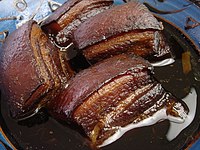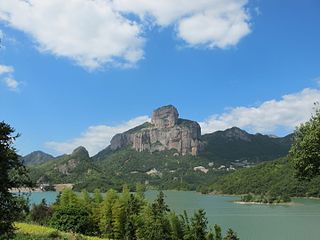
Zhejiang is an eastern coastal province of the People's Republic of China. Its capital and largest city is Hangzhou, and other notable cities include Ningbo and Wenzhou. Zhejiang is bordered by Jiangsu and Shanghai to the north, Anhui to the northwest, Jiangxi to the west and Fujian to the south. To the east is the East China Sea, beyond which lies the Ryukyu Islands. The population of Zhejiang stands at 64.6 million, the 8th highest among China. It has been called "the backbone of China" because it is a major driving force in the Chinese economy and being the birthplace of several notable people, including the Chinese Nationalist leader Chiang Kai-shek and entrepreneur Jack Ma. Zhejiang consists of 90 counties.

Hangzhou, also romanized as Hangchow, is the capital and most populous city of Zhejiang, China. It is located in the northwestern part of the province, sitting at the head of Hangzhou Bay, which separates Shanghai and Ningbo. Hangzhou grew to prominence as the southern terminus of the Grand Canal and has been one of China's most renowned and prosperous cities for much of the last millennium. It is a major economic and e-commerce hub within China, and the second biggest city in Yangtze Delta after Shanghai. Hangzhou is classified as a sub-provincial city and forms the core of the Hangzhou metropolitan area, the fourth-largest in China after Guangzhou-Shenzhen Pearl River agglomeration, Shanghai-Suzhou-Wuxi-Changzhou conurbation and Beijing. As of 2019, the Hangzhou metropolitan area was estimated to produce a gross metropolitan product (nominal) of 3.2 trillion yuan, making it larger than the economy of Nigeria. As of the 2020 Chinese census, it had a total population of 11,936,010 inhabitants. However, its metropolitan area, populated by 13.035 million people over an area of 8,107.9 km2 (3,130.5 sq mi), consists of all urban districts in Hangzhou and 3 urban districts of the city of Shaoxing.

Jiangnan, also romanized as Kiangnan, Chiang-nan, and Jiang Nan, is a geographic area in China referring to lands immediately to the south of the lower reaches of the Yangtze River, including the southern part of its delta. The region encompasses the city of Shanghai, the southern part of Jiangsu Province, the southeastern part of Anhui Province, the northern part of Jiangxi Province and the northern part of Zhejiang Province. The most important cities in the area include Anqing, Changzhou, Hangzhou, Nanjing, Ningbo, Shaoxing, Suzhou, Wuxi, Wenzhou, Yangzhou and Zhenjiang.
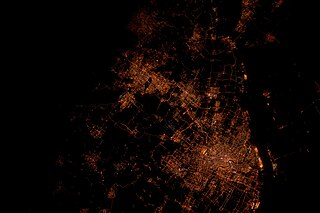
The Yangtze Delta or Yangtze River Delta is a triangle-shaped megalopolis generally comprising the Wu Chinese-speaking areas of Shanghai, southern Jiangsu, northern Zhejiang and northern Jiangxi. The area lies in the heart of the Jiangnan region, where the Yangtze River drains into the East China Sea. Having fertile soil, the Yangtze Delta abundantly produces grain, cotton, hemp and tea. In 2018, the Yangtze Delta had a GDP of approximately US$2.2 trillion, about the same size as Italy.

Tāizhōu, alternately known as Taichow, is a city located at the middle of the East China Sea coast of Zhejiang province. It is located 300 km (190 mi) south of Shanghai and 230 km (140 mi) southeast of Hangzhou, the provincial capital. It is bordered by Ningbo to the north, Wenzhou to the south, and Shaoxing, Jinhua, and Lishui to west. In addition to the municipality itself, the prefecture-level city of Taizhou includes 3 districts, 3 county-level cities, and 3 counties. As of the 2020 census, its total population was 6,662,888 inhabitants whom 3,578,660 lived in the built-up area made of the three urban Districts and Wenling City now being largely conurbated.
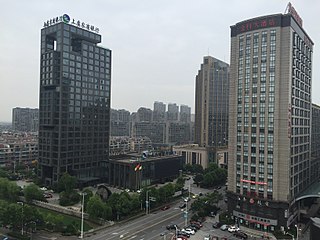
Shangyu District is a district of the prefecture-level city of Shaoxing in the northeast of Zhejiang province, China. At the 2010 census, its population in the built-up area was 779,412, up from 722,523 in the 2000 census. Shangyu is roughly fifty kilometers from north to south and about thirty kilometers from east to west. It makes up about one-fourth of the area of Shaoxing prefecture. Shangyu District is not part of the Hangzhou-Shaoxing built-up area as some countryside still prevent the city from being conurbated until now.

Jinhua (help·info), alternately romanized as Kinhwa, is a prefecture-level city in central Zhejiang province in eastern China. It borders the provincial capital of Hangzhou to the northwest, Quzhou to the southwest, Lishui to the south, Taizhou to the east, and Shaoxing to the northeast. Its population was 7,050,683 as of the 2020 census including 1,463,990 in the built-up area made of two urban districts.

Hangzhou Bay, or the Bay of Hangzhou, is a funnel-shaped inlet of the East China Sea, bordered by the province of Zhejiang and the municipality of Shanghai, which lies north of the Bay. The Bay extends from the East China Sea to its head at the city of Hangzhou, from which its name is derived.
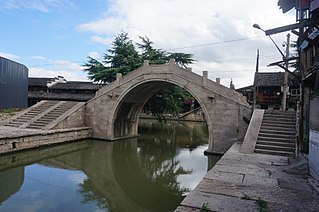
Keqiao District, formerly Shaoxing County, is a district of the city of Shaoxing in Zhejiang province, China.
Taihu Wu (吳語太湖片) or Northern Wu (北部吳語) is a Wu Chinese language spoken over much of southern part of Jiangsu province, including Suzhou, Wuxi, Changzhou, the southern part of Nantong, Jingjiang and Danyang; the municipality of Shanghai; and the northern part of Zhejiang province, including Hangzhou, Shaoxing, Ningbo, Huzhou, and Jiaxing. A notable exception is the dialect of the town of Jinxiang, which is a linguistic exclave of Taihu Wu in Zhenan Min-speaking Cangnan county of Wenzhou prefecture in Zhejiang province. Speakers in regions around Taihu Lake and Hangzhou Bay, are the largest population among all Wu speakers. Taihu Wu dialects such as Shanghainese, Shaoxing and Ningbo are mutually intelligible even for L2 Taihu speakers.
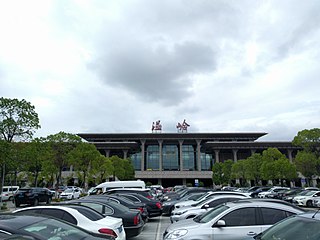
Wenling railway station is a railway station on the Ningbo–Taizhou–Wenzhou railway and the Hangzhou–Taizhou high-speed railway located in Wenling, Taizhou, Zhejiang, China.

The Ningbo–Taizhou–Wenzhou railway or Yong-Tai-Wen railway is a dual-track, electrified, high-speed rail line in Zhejiang Province, China. It is named after the three prefecture-level cities along route: Ningbo, whose abbreviated Chinese name is Yong, Taizhou and Wenzhou. The line has a total length of 282.4 kilometres (175.5 mi) and forms part of Hangzhou–Fuzhou–Shenzhen railway. Construction began in October 2005, and the line opened to commercial service on September 28, 2009. Trains running on the line reach top speeds of 250 kilometres per hour, and the shortest trip between Ningbo and Wenzhou takes 1 hour 12 minutes.
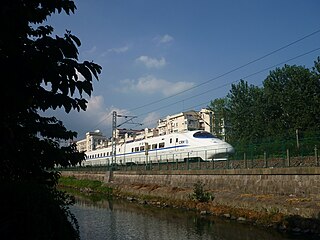
The Xiaoshan–Ningbo railway or Xiaoyong railway, is a double-track railroad in eastern China between Hangzhou and Ningbo in Zhejiang Province. Its name in Chinese, the Xiaoyong Line, is named after the railway's two terminal stations, Hangzhou South in Xiaoshan District of Hangzhou on the southern bank of Qiantang River, and Ningbo, whose Chinese character abbreviation is yong. The line is 147.3 km (92 mi) long and was originally built in three parts in 1912, 1914 and 1936; rebuilt in 1959, then electrified in 2009. Cities along route include Xiaoshan District of Hangzhou, Shaoxing, Shangyu, Yuyao and Ningbo, all in Zhejiang Province. The Hangzhou–Ningbo high-speed railway runs parallel to the line. The section between Ningbo and Zhuangqiao railway station is proposed to be quadruple-tracked.

Chinese regional cuisines are amongst the many different cuisines found in different provinces and prefectures of China as well as from larger overseas Chinese communities.
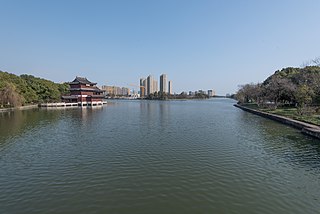
The Eastern Zhejiang Canal is located in Zhejiang province, China. Its west end is in Xixing Street, Binjiang District, Hangzhou City, crossing Cao'e River and Shaoxing City to its east end, the Yong River estuary in Ningbo City. The canal is 239 kilometres (149 mi) long. Early canal construction took place in the Shanyin old canal in Shaoxing City, during the Spring and Autumn period. In the third century AD, an official named He Xun supervised the construction of Xixing Canal, establishing the complete Eastern Zhejiang Canal.

Lou Wai Lou is a traditional restaurant in Hangzhou, Zhejiang, China, located on Gushan in the middle of the West Lake. It was established in the 28th year of the reign of Emperor Daoguang of the Qing dynasty (1848). It has been named a "China Time-honored Brand" by the Chinese government.
Xu Liyi is a Chinese politician who served as party secretary of Zhengzhou from 2019 to 2022. He was removed from his post due to under-report the number of people who died or went missing during the 2021 Henan floods. He previously served as mayor of Hangzhou and before that, mayor and party secretary of Wenzhou. He is a delegate to the 13th National People's Congress.
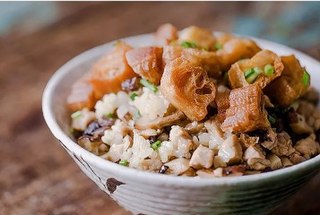
Ou cuisine, alternatively known as Wenzhou cuisine, is one of the four schools of Zhejiang cuisine, whereas Zhejiang cuisine is one of the eight major cuisines in China. The ancient name of Wenzhou is called DongOu. After the founding of the People’s Republic of China, in order to improve the popularity of Wenzhou cuisine, catering experts has renamed the cuisine with its ancient name, as “Ou cai”. The major elements in ou cuisine are seafood, which tastes fresh, light, and not bland. During the cooking process, it emphasizes "two light and a heavy," that is, light oil, light thickening, and heavy knife action, and it has a noticeable distinctive style.
